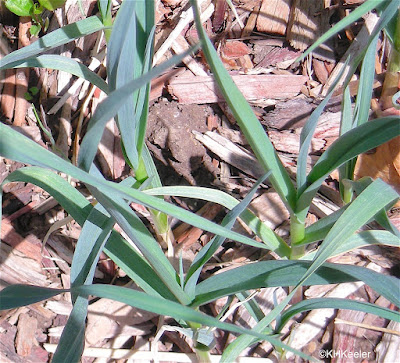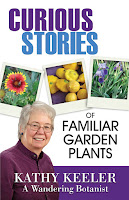 |
| Garlic bulb |
Garlic (Allium sativum, amaryllis family, Amaryllidaceae) is thought to be native to central Asia but at least 5,000 years ago it was carried all over Eurasia--to the Middle East, India and China and then Southeast Asia, Africa, Europe and, eventually, the New World. It became an essential part of the diet everywhere it went, to the dismay of those who do not like it.
 |
| garlic in garden |
The name garlic is an old English (or maybe older, German) combination of gar (from gare, a spear) and leac (a leek and more generally a pot herb), referring to the spear-shaped leaf.
 |
| garlic leaves |
Highlights of the history of garlic as a medicine include the recommendation to eat a clove of garlic every day--it was considered a potent preventative medicine. It was heavily used in the First World War and, in the Second World War, on the Russian Front as an antibiotic and antiseptic. From those uses come its nicknames, "country man's treacle" (treacle was a sugar syrup used to cure everything: sugar was much more expensive than garlic in Europe until quite recently) and "Russian penicillin." Its use as a medicine declined since the advent of penicillin but it is still an effective an antibiotic, with other verified medical uses. I refer you to medical sources for more on it as a medicine (web md consumer reports) and to cookbooks for its use in food (BBC, video).
Since it was known to everyone, garlic has lots of folklore.
Consider:
Garlic was associated in ancient Greece with the goddess, Hecate (link, link). Goddess of the underworld and magic, Hecate could be kind but she commanded powerful evil forces. Offerings to her were prudent. She was frequently portrayed at building entrances, crossroads and other places where you might encounter dangerous strangers. Garlic was among the offerings considered appropriate.
 Throughout European and Asian history, people hung garlic in front of their doors to protect from sorcerers, demons, illness and the evil eye. And to ward off thieves. If you had a thatched or sod roof, you could plant it on the roof for protection.
Throughout European and Asian history, people hung garlic in front of their doors to protect from sorcerers, demons, illness and the evil eye. And to ward off thieves. If you had a thatched or sod roof, you could plant it on the roof for protection.If a mean spirit threatened, you could protect yourself by biting into a clove of garlic and throwing it as far as you could. The garlic would take the spirit with it.
Garlic was worn to protect from evil generally but especially against the plague. Lots of plague survivors gave credit to the garlic.
Mountaineers wore garlic for protection from foul weather and monsters. Korean travelers ate garlic to ward off tigers.
Sailors took it with them aboard ship to protect the ship.
Brides carried a clove of garlic during the wedding for good luck and ward off evil. Garlic was put into the cradle to protect the baby.
In England and North America, slices of garlic were put into children's shoes, against the sole of the foot, to protect them from whooping cough.
Warding off vampires with garlic appears to have developed as a story in the last couple centuries, as writers embellished eastern European folktales of human vampires (Live Science on vampires link). Given garlic's long history warding off evil, this was a logical choice.

It had serious detractors:
Culpeper warned that in choleric men (ruddy, hot tempered) it worstened the condition; in melancholy ones (cold, depressed), garlic provoked strange fantasies and visions.
Evelyn, writing in 1699, asserted eating garlic had previously been a punishment for "the horrid'st Crimes."
 |
| clove of garlic, partly peeled |
Garlic would give you an advantage in a race, either by eating it or hanging it from your horse where the smell would discourage the other horses.
 |
| ripening garlic |
Comments and corrections welcome.
Stories gathered from
Burrell, D. 2008. Superstitions. Readers' Digest Publications, Pleasantville, New York.
Culpeper, N. Culpeper's Complete Herbal. W. Foulsham and Co., London. Online: link
Cunningham, S. 1984. Cunningham's Encyclopedia of Magical Herbs. Llewellyn Publications, St. Paul, Minnesota.
Evelyn, J. 1699 Acetaria. edited by M. Masson as The Grand Salad. Peacock Vane Publishing Isle of Wight.
Grieve, Mrs. M. 1932. A Modern Herbal. Dover Publications, New York. Online: link
Harrison, L. 2011. A Potted History of Vegetables. Lyons Press, Guilford, Connecticut.
Kamm, M. W. 1971. Old Time Herbs for Northern Gardens. Dover Publications, New York.
Radford, E and M. A. Radford. 1961. Encyclopedia of Superstitions. Edited and revised by C. Hole. Hutchinson Publishing, New York.
Vickery, R. 1995. Oxford Dictionary of Plant Lore. Oxford University Press, Oxford, England.
Zevin, I. V. 1997. A Russian Herbal. Healing Arts Press, Rochester, Vermont.
About garlic
Growing garlic in Western Australia link
"garlic, n.". OED Online. December 2018. Oxford University Press. ">http://www.oed.com.libproxy.unl.edu (accessed December 03, 2018).
Find similar stories in my books: Curious Stories of Familiar Garden Plants link and Curious Stories of Plants from Around the World link, available on amazon.com or from me.
Kathy Keeler, A Wandering Botanist
More at awanderingbotanist.com



No comments:
Post a Comment